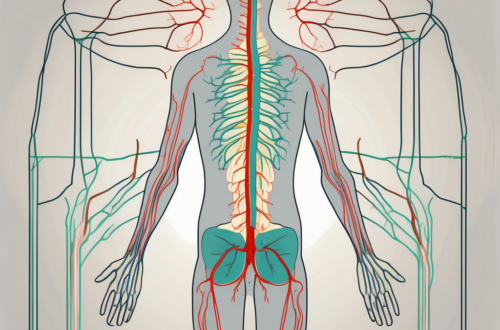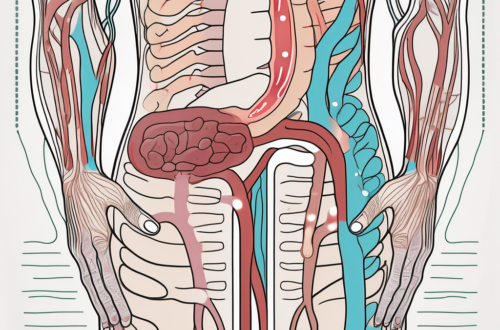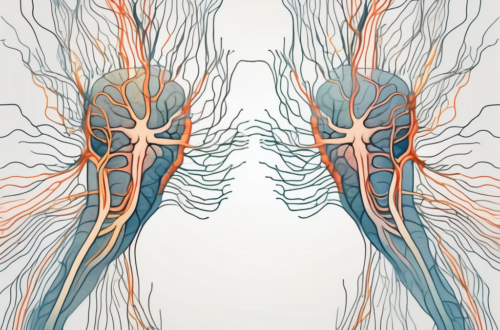The human body is an intricate system of interconnected organs and networks, each performing its unique role in maintaining overall health and well-being. One such crucial system is the autonomic nervous system, which plays a pivotal role in regulating various bodily functions, including heart rate. Within this system, the primary parasympathetic nerve takes center stage in the intricate balance between the sympathetic and parasympathetic branches.
Understanding the Parasympathetic Nervous System
The parasympathetic nervous system is one of two main branches of the autonomic nervous system, working in harmony with the sympathetic nervous system to maintain balance and homeostasis in the body. While the sympathetic nervous system is responsible for the “fight or flight” response, the parasympathetic nervous system is often referred to as the “rest and digest” system.
The parasympathetic branch is primarily responsible for slowing heart rate and conserving energy. It actively works to counterbalance the effects of sympathetic stimulation, promoting a state of relaxation and calmness in the body. For the purpose of this article, we will focus specifically on the role of the primary parasympathetic nerve in lowering heart rate.
The Function and Importance of the Parasympathetic Nervous System
The parasympathetic nervous system plays a vital role in maintaining cardiovascular health and overall well-being. By exerting its influence on the heart, it helps to regulate heart rate and maintain optimal cardiac function. This delicate balance of the autonomic nervous system ensures that the heart is able to adapt to changing physiological demands, maintaining a stable rhythm in various situations.
Furthermore, the parasympathetic nervous system not only affects the heart but also aids in the digestion and absorption of nutrients by increasing blood flow to the digestive organs. This increased blood flow promotes efficient digestion and nutrient assimilation. Additionally, it helps to constrict smooth muscles in the gastrointestinal tract, facilitating proper movement of food and waste through the digestive system.
Moreover, the parasympathetic nervous system has been found to have a profound impact on mental health. Activation of the parasympathetic nervous system has been associated with reduced anxiety and stress levels, leading to an overall sense of well-being and calmness. This is due to the release of neurotransmitters such as acetylcholine, which promote relaxation and a sense of tranquility.
The Parasympathetic Nervous System and the Heart
The parasympathetic nervous system exerts its influence on the heart through the primary parasympathetic nerve, often referred to as the vagus nerve. The vagus nerve originates in the medulla oblongata, a region of the brainstem, and extends down into the chest and abdomen, eventually reaching the heart. This intricate connection allows for precise control and regulation of heart rate.
When the primary parasympathetic nerve is stimulated, it releases acetylcholine, a neurotransmitter that binds to specialized receptors in the heart known as muscarinic receptors. Activation of these receptors leads to a series of events within the heart that result in a decreased heart rate.
Furthermore, the parasympathetic nervous system also influences other aspects of cardiac function, such as the strength of heart contractions and the conduction of electrical signals within the heart. By modulating these factors, the parasympathetic nervous system helps to maintain a steady and efficient pumping action, ensuring adequate blood flow to all parts of the body.
In conclusion, the parasympathetic nervous system is a crucial component of the autonomic nervous system, working alongside the sympathetic nervous system to maintain balance and homeostasis in the body. Its role in regulating heart rate, promoting digestion, and inducing a state of relaxation highlights its importance in overall health and well-being.
The Primary Parasympathetic Nerve: An Overview
Now, let us delve deeper into the anatomy and connection between the primary parasympathetic nerve and the heart. Understanding these intricate details will enhance our comprehension of the fascinating mechanism of heart rate regulation.
Anatomy of the Primary Parasympathetic Nerve
The primary parasympathetic nerve, the vagus nerve, is the longest cranial nerve in the body and is responsible for providing parasympathetic innervation to many organs, including the heart. It consists of both motor and sensory fibers, allowing for bidirectional communication between the brain and various parts of the body.
The vagus nerve originates in the medulla oblongata, a region located at the base of the brainstem. From there, it descends through the neck, chest, and abdomen, sending branches to different organs along its course.
As the vagus nerve approaches the heart, it gives rise to multiple branches that form the cardiac plexuses. These plexuses are dense networks of nerve fibers that intertwine with the cardiac muscle, forming an intricate network that allows for precise regulation of heart rate and rhythm.
Within the cardiac plexuses, the vagus nerve fibers interact with specialized cells called ganglia. These ganglia serve as relay stations, facilitating communication between the nerve fibers and the cardiac muscle cells.
The Connection between the Primary Parasympathetic Nerve and the Heart
The primary parasympathetic nerve connects with the heart through specialized structures known as cardiac plexuses. These plexuses are dense networks of nerve fibers that intersect with the cardiac muscle to exert their influence on heart rate.
When the primary parasympathetic nerve is stimulated, impulses travel along its fibers and reach the cardiac plexuses. From there, the message is transmitted to the sinoatrial (SA) node, often referred to as the heart’s “natural pacemaker.” The SA node is responsible for generating electrical impulses that initiate each heartbeat.
Stimulation of the primary parasympathetic nerve leads to the release of acetylcholine onto the SA node, causing a decrease in its firing rate. As a result, the heart rate slows down, allowing for a more controlled and efficient cardiac cycle.
It is important to note that the primary parasympathetic nerve does not solely regulate heart rate. It also influences other aspects of cardiac function, such as the force of contraction and the conduction of electrical signals within the heart.
Besides its role in heart rate regulation, the vagus nerve is involved in various other physiological processes. It plays a crucial role in the regulation of digestion, respiratory function, and even emotional responses. Dysfunction of the vagus nerve can lead to a variety of health conditions, including heart rhythm disorders, gastrointestinal disorders, and mood disorders.
Research has shown that the primary parasympathetic nerve can be modulated through various interventions. Techniques such as deep breathing exercises, meditation, and certain medications can enhance parasympathetic activity, promoting relaxation and reducing stress. Conversely, certain medical conditions or medications can suppress parasympathetic activity, leading to increased heart rate and other physiological changes.
In conclusion, the primary parasympathetic nerve, represented by the vagus nerve, plays a vital role in regulating heart rate and maintaining cardiac function. Its intricate anatomy and connection with the heart allow for precise control over the heart’s electrical activity. Understanding the mechanisms by which the primary parasympathetic nerve influences the heart can provide valuable insights into the treatment and management of various cardiovascular conditions.
The Mechanism of Heart Rate Regulation
Now that we have gained insights into the fascinating relationship between the primary parasympathetic nerve and the heart, let us explore the broader mechanism of heart rate regulation. This intricate process involves the orchestration of various factors, including the autonomic nervous system.
The regulation of heart rate is a complex and dynamic process that ensures the proper functioning of the cardiovascular system. It involves a delicate balance between the sympathetic and parasympathetic branches of the autonomic nervous system, which work together to maintain cardiovascular homeostasis.
The autonomic nervous system, comprising the sympathetic and parasympathetic branches, plays a crucial role in modulating heart rate and maintaining cardiovascular homeostasis. While the sympathetic nervous system stimulates the heart to increase its rate and force of contraction, the parasympathetic nervous system performs the opposite function of decreasing heart rate.
It is worth noting that the exact balance between sympathetic and parasympathetic influences on heart rate varies based on the body’s needs and physiological state. Under normal resting conditions, the parasympathetic influence predominates, resulting in a relatively low resting heart rate.
The sympathetic nervous system, often referred to as the “fight-or-flight” response, is responsible for increasing heart rate and preparing the body for action in response to stress or danger. This response is mediated by the release of norepinephrine, a neurotransmitter that binds to beta-adrenergic receptors in the heart, leading to an increase in heart rate and contractility.
On the other hand, the parasympathetic nervous system, also known as the “rest-and-digest” response, counteracts the sympathetic response by releasing acetylcholine, which binds to muscarinic receptors in the heart. This binding inhibits the production of cyclic adenosine monophosphate (cAMP), a molecule that plays a key role in the regulation of heart rate. As a result, heart rate decreases, allowing the body to conserve energy and promote relaxation.
How the Primary Parasympathetic Nerve Influences Heart Rate
The primary parasympathetic nerve exerts its influence on heart rate through a process known as vagal tone. Vagal tone refers to the degree of activity in the parasympathetic nervous system. Higher vagal tone corresponds to increased parasympathetic activity, resulting in a slower heart rate.
The primary parasympathetic nerve, also known as the vagus nerve, originates in the medulla oblongata of the brainstem and extends down to the heart. It releases acetylcholine, which binds to muscarinic receptors on the surface of cardiac cells. This binding activates a signaling pathway that leads to the opening of potassium channels and the closing of calcium channels, ultimately slowing down the heart rate.
Factors such as breathing, emotions, and physical activity can all affect vagal tone and, subsequently, heart rate. For example, deep and slow breathing exercises, such as those practiced in meditation or yoga, can stimulate the parasympathetic nervous system and promote a more relaxed state, leading to a decrease in heart rate.
Emotions, such as stress or anxiety, can have the opposite effect on vagal tone. When faced with a stressful situation, the sympathetic nervous system becomes more dominant, leading to an increase in heart rate and blood pressure. This response is part of the body’s natural defense mechanism, preparing it for action.
Physical activity also has a significant impact on heart rate regulation. During exercise, the sympathetic nervous system is activated to increase heart rate and cardiac output, ensuring an adequate supply of oxygen and nutrients to the working muscles. As exercise intensity increases, sympathetic activity becomes more pronounced, leading to a higher heart rate.
In summary, the regulation of heart rate is a complex process involving the interplay between the sympathetic and parasympathetic branches of the autonomic nervous system. The primary parasympathetic nerve, through vagal tone, exerts its influence on heart rate by slowing it down. Factors such as breathing, emotions, and physical activity can modulate vagal tone and, consequently, heart rate. Understanding this intricate mechanism is crucial for maintaining cardiovascular health and optimizing overall well-being.
The Impact of Parasympathetic Nerve Stimulation on Heart Rate
Having understood the mechanism of parasympathetic control over heart rate, we can now explore the impact of parasympathetic nerve stimulation on heart rate regulation. This knowledge is not only fascinating from a physiological standpoint but also holds clinical significance in understanding heart rate disorders and potential therapeutic approaches.
The Process of Parasympathetic Nerve Stimulation
Parasympathetic nerve stimulation can occur through a variety of mechanisms, each influencing heart rate in its unique way. For instance, physical activity, such as running or cycling, often stimulates the parasympathetic nervous system to a lesser extent, resulting in an increase in heart rate to meet the increased oxygen demand. Conversely, relaxation techniques, as mentioned earlier, can stimulate the parasympathetic nervous system, leading to a decrease in heart rate.
Moreover, the impact of parasympathetic nerve stimulation on heart rate goes beyond just exercise and relaxation. Other factors such as emotional states, environmental conditions, and even certain medications can also influence parasympathetic activity and subsequently affect heart rate. For example, during moments of intense stress or fear, the parasympathetic nervous system may be temporarily suppressed, leading to an increase in heart rate as the body prepares for a fight-or-flight response.
Furthermore, environmental factors such as temperature can also play a role in parasympathetic nerve stimulation. Cold temperatures, for instance, can trigger the body’s natural response to conserve heat, leading to increased parasympathetic activity and a subsequent decrease in heart rate. On the other hand, exposure to warm temperatures can have the opposite effect, promoting vasodilation and increasing heart rate to facilitate heat dissipation.
It is important to note that parasympathetic nerve stimulation can also be clinically induced through the administration of certain medications or specific medical procedures. These approaches are carefully considered and administered by healthcare professionals according to individual patient needs and medical guidelines.
The Direct Effects of Parasympathetic Stimulation on Heart Rate
Direct parasympathetic stimulation, as in the case of vagal maneuvers or certain medications, can have a profound impact on heart rate. Vagal maneuvers refer to specific physical actions that stimulate the vagus nerve and subsequently slow down the heart rate. Common examples of vagal maneuvers include the Valsalva maneuver, carotid sinus massage, or immersion in cold water.
However, it is essential to exercise caution when attempting vagal maneuvers without appropriate medical supervision. While they can be effective in certain situations, the response to vagal stimulation can vary between individuals, and complications can arise in some cases.
Additionally, certain medications can directly target the parasympathetic nervous system to regulate heart rate. These medications, known as parasympathomimetic drugs, mimic the effects of acetylcholine, the neurotransmitter responsible for parasympathetic nerve stimulation. By binding to specific receptors in the heart, these drugs can slow down the heart rate and help manage conditions such as tachycardia or atrial fibrillation.
In conclusion, parasympathetic nerve stimulation plays a crucial role in heart rate regulation. From the various mechanisms that influence parasympathetic activity to the direct effects of stimulation through vagal maneuvers or medications, understanding the impact of parasympathetic nerve stimulation on heart rate provides valuable insights into both physiological processes and potential therapeutic interventions.
The Clinical Significance of Parasympathetic Control of Heart Rate
Now that we have explored the intricate details of parasympathetic control of heart rate, it is important to consider the clinical significance of this mechanism. Disorders or dysfunctions in the parasympathetic nervous system can have profound impacts on heart rate regulation and overall cardiovascular health. Recognizing these conditions and seeking appropriate medical advice is paramount in maintaining optimal well-being.
Parasympathetic Nerve Dysfunction and Heart Rate Disorders
Disruptions in parasympathetic nerve function can lead to abnormal heart rate patterns, such as bradycardia (slow heart rate) or tachycardia (fast heart rate). These conditions can have various underlying causes, including certain medical conditions, medication side effects, or autonomic nervous system disorders.
If you are experiencing persistent heart rate irregularities or cardiac symptoms, it is imperative to consult with a healthcare professional. They will be able to conduct a thorough evaluation, perform appropriate diagnostic tests, and recommend a tailored treatment plan, if necessary.
Therapeutic Approaches Targeting Parasympathetic Control of Heart Rate
In certain cases, healthcare professionals may use therapeutic approaches that target parasympathetic control of heart rate. These approaches aim to modulate parasympathetic activity and restore optimal heart rate regulation. However, it is important to note that these interventions should only be pursued under medical guidance and supervision, as each patient’s condition and treatment requirements are unique.
Furthermore, it is crucial to maintain open and honest communication with your healthcare provider, discussing any concerns or questions you may have regarding treatment options or potential side effects.
In Conclusion
The primary parasympathetic nerve, working in coordination with the autonomic nervous system, plays a vital role in regulating heart rate and maintaining cardiovascular health. Its influence on the heart through the release of acetylcholine helps to slow down the heart rate, promoting relaxation and efficient cardiac function.
Understanding the intricate relationship between the primary parasympathetic nerve and heart rate regulation enables us to recognize the clinical significance of parasympathetic dysfunction and develop targeted therapeutic approaches when necessary. Remember, if you have any concerns about your heart rate or cardiovascular health, it is always best to seek advice from a qualified healthcare professional who can provide appropriate guidance based on your individual circumstances.





